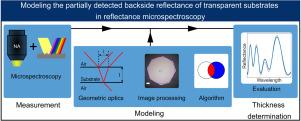Modeling the partially detected backside reflectance of transparent substrates in reflectance microspectroscopy
IF 2.2
3区 工程技术
Q1 MICROSCOPY
引用次数: 0
Abstract
Thick transparent substrates are a key component for transmissive thin film optical filters and optoelectronics. In optical characterization of such substrates, light reflected from the backside — whether fully or partially detected — interferes with light directly reflected from the substrate’s front side. Herein, we introduce a straightforward approach for microspectroscopic measurements, with lateral dimensions in the micrometer range, to reliably assess the amount of measured backside reflectance. Therefore, geometric calculations based on micrographs, substrate thickness and refractive index, as well as magnification of the applied objective lens are utilized as input parameters. Additionally, we account for the influence of the numerical aperture, which is essential for accurate determination of the properties of thin films coated on thick transparent substrates. Compared to simulations completely incorporating or entirely neglecting the backside reflectance, our approach significantly reduces the mean squared error between measurement and model in the case of partially detected backside reflectance. After demonstrating the capabilities of our approach to accurately identify the amount of backside reflectance detected for a variety of bare transparent substrate materials, thicknesses, and objective lenses, we prove the capacity to determine the thickness of silicon nitride and silicon nitride/silicon oxide layers on glass substrates with high consistency to complementary STEM/EDX measurements even for large numerical apertures.

在反射微光谱学中对透明衬底部分检测的背面反射率进行建模
厚透明衬底是透射式薄膜滤光片和光电子学的关键部件。在这类基板的光学特性中,从背面反射的光——无论是完全被检测到还是部分被检测到——都会干扰从基板正面直接反射的光。在此,我们介绍了一种直接的显微光谱测量方法,其横向尺寸在微米范围内,以可靠地评估测量的背面反射率。因此,基于显微图的几何计算,衬底厚度和折射率,以及所应用物镜的放大倍率被用作输入参数。此外,我们考虑了数值孔径的影响,这对于准确测定厚透明衬底上涂覆的薄膜的性质是必不可少的。与完全包含或完全忽略后反射率的模拟相比,在部分检测到后反射率的情况下,我们的方法显着降低了测量和模型之间的均方误差。在展示了我们的方法准确识别各种裸透明衬底材料、厚度和物镜检测到的背面反射率的能力之后,我们证明了确定玻璃衬底上氮化硅和氮化硅/氧化硅层厚度的能力,即使对于大数值孔径,也能与互补的STEM/EDX测量高度一致。
本文章由计算机程序翻译,如有差异,请以英文原文为准。
求助全文
约1分钟内获得全文
求助全文
来源期刊

Micron
工程技术-显微镜技术
CiteScore
4.30
自引率
4.20%
发文量
100
审稿时长
31 days
期刊介绍:
Micron is an interdisciplinary forum for all work that involves new applications of microscopy or where advanced microscopy plays a central role. The journal will publish on the design, methods, application, practice or theory of microscopy and microanalysis, including reports on optical, electron-beam, X-ray microtomography, and scanning-probe systems. It also aims at the regular publication of review papers, short communications, as well as thematic issues on contemporary developments in microscopy and microanalysis. The journal embraces original research in which microscopy has contributed significantly to knowledge in biology, life science, nanoscience and nanotechnology, materials science and engineering.
 求助内容:
求助内容: 应助结果提醒方式:
应助结果提醒方式:


